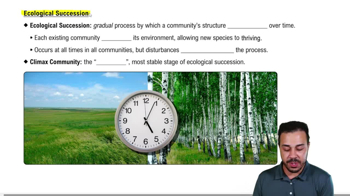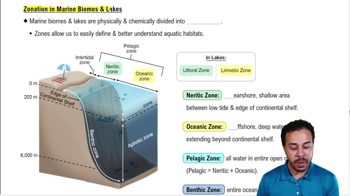Table of contents
- 1. Introduction to Biology2h 40m
- 2. Chemistry3h 40m
- 3. Water1h 26m
- 4. Biomolecules2h 23m
- 5. Cell Components2h 26m
- 6. The Membrane2h 31m
- 7. Energy and Metabolism2h 0m
- 8. Respiration2h 40m
- 9. Photosynthesis2h 49m
- 10. Cell Signaling59m
- 11. Cell Division2h 47m
- 12. Meiosis2h 0m
- 13. Mendelian Genetics4h 41m
- Introduction to Mendel's Experiments7m
- Genotype vs. Phenotype17m
- Punnett Squares13m
- Mendel's Experiments26m
- Mendel's Laws18m
- Monohybrid Crosses16m
- Test Crosses14m
- Dihybrid Crosses20m
- Punnett Square Probability26m
- Incomplete Dominance vs. Codominance20m
- Epistasis7m
- Non-Mendelian Genetics12m
- Pedigrees6m
- Autosomal Inheritance21m
- Sex-Linked Inheritance43m
- X-Inactivation9m
- 14. DNA Synthesis2h 27m
- 15. Gene Expression3h 20m
- 16. Regulation of Expression3h 31m
- Introduction to Regulation of Gene Expression13m
- Prokaryotic Gene Regulation via Operons27m
- The Lac Operon21m
- Glucose's Impact on Lac Operon25m
- The Trp Operon20m
- Review of the Lac Operon & Trp Operon11m
- Introduction to Eukaryotic Gene Regulation9m
- Eukaryotic Chromatin Modifications16m
- Eukaryotic Transcriptional Control22m
- Eukaryotic Post-Transcriptional Regulation28m
- Eukaryotic Post-Translational Regulation13m
- 17. Viruses37m
- 18. Biotechnology2h 58m
- 19. Genomics17m
- 20. Development1h 5m
- 21. Evolution3h 1m
- 22. Evolution of Populations3h 52m
- 23. Speciation1h 37m
- 24. History of Life on Earth2h 6m
- 25. Phylogeny2h 31m
- 26. Prokaryotes4h 59m
- 27. Protists1h 12m
- 28. Plants1h 22m
- 29. Fungi36m
- 30. Overview of Animals34m
- 31. Invertebrates1h 2m
- 32. Vertebrates50m
- 33. Plant Anatomy1h 3m
- 34. Vascular Plant Transport2m
- 35. Soil37m
- 36. Plant Reproduction47m
- 37. Plant Sensation and Response1h 9m
- 38. Animal Form and Function1h 19m
- 39. Digestive System10m
- 40. Circulatory System1h 57m
- 41. Immune System1h 12m
- 42. Osmoregulation and Excretion50m
- 43. Endocrine System4m
- 44. Animal Reproduction2m
- 45. Nervous System55m
- 46. Sensory Systems46m
- 47. Muscle Systems23m
- 48. Ecology3h 11m
- Introduction to Ecology20m
- Biogeography14m
- Earth's Climate Patterns50m
- Introduction to Terrestrial Biomes10m
- Terrestrial Biomes: Near Equator13m
- Terrestrial Biomes: Temperate Regions10m
- Terrestrial Biomes: Northern Regions15m
- Introduction to Aquatic Biomes27m
- Freshwater Aquatic Biomes14m
- Marine Aquatic Biomes13m
- 49. Animal Behavior28m
- 50. Population Ecology3h 41m
- Introduction to Population Ecology28m
- Population Sampling Methods23m
- Life History12m
- Population Demography17m
- Factors Limiting Population Growth14m
- Introduction to Population Growth Models22m
- Linear Population Growth6m
- Exponential Population Growth29m
- Logistic Population Growth32m
- r/K Selection10m
- The Human Population22m
- 51. Community Ecology2h 46m
- Introduction to Community Ecology2m
- Introduction to Community Interactions9m
- Community Interactions: Competition (-/-)38m
- Community Interactions: Exploitation (+/-)23m
- Community Interactions: Mutualism (+/+) & Commensalism (+/0)9m
- Community Structure35m
- Community Dynamics26m
- Geographic Impact on Communities21m
- 52. Ecosystems2h 36m
- 53. Conservation Biology24m
48. Ecology
Introduction to Ecology
Problem 6b
Textbook Question
Textbook QuestionWhen climbing a mountain, we can observe transitions in biological communities that are analogous to the changes a. in biomes at different latitudes. b. in different depths in the ocean. c. in a community through different seasons. d. in an ecosystem as it evolves over time.
 Verified step by step guidance
Verified step by step guidance1
Step 1: Understand the question. The question is asking about the changes in biological communities that we can observe when climbing a mountain. These changes are analogous to some other type of change in nature.
Step 2: Review each of the options and consider how they relate to changes in biological communities. Option a suggests that the changes are similar to those in biomes at different latitudes. Option b suggests a similarity to changes in different depths in the ocean. Option c suggests a similarity to changes in a community through different seasons. Option d suggests a similarity to changes in an ecosystem as it evolves over time.
Step 3: Consider the nature of changes when climbing a mountain. As we ascend, the temperature and pressure decrease, and the types of plants and animals we encounter change. This is similar to moving from the equator towards the poles, where temperature and pressure also decrease and the types of organisms change.
Step 4: Compare this to the other options. Changes in ocean depth are more about pressure and light levels than temperature. Changes through seasons are cyclical and reversible, unlike a mountain climb. Changes in an ecosystem over time (ecological succession) are about the ecosystem's development and maturation, not a steady change in conditions like temperature or pressure.
Step 5: Conclude that the changes in biological communities when climbing a mountain are most analogous to the changes in biomes at different latitudes (option a), as both involve a steady change in conditions like temperature and pressure, leading to different types of organisms being present.
Recommended similar problem, with video answer:
 Verified Solution
Verified SolutionThis video solution was recommended by our tutors as helpful for the problem above
Video duration:
2mPlay a video:
Was this helpful?
Key Concepts
Here are the essential concepts you must grasp in order to answer the question correctly.
Biomes and Latitude
Biomes are large ecological areas characterized by specific climate conditions, flora, and fauna. They vary with latitude, as temperature and precipitation patterns change from the equator to the poles. Understanding how biomes shift with latitude helps explain the diversity of life forms and adaptations found in different regions.
Recommended video:
Guided course

Introduction to Aquatic Biomes
Ecological Succession
Ecological succession is the process by which ecosystems change and develop over time, often following a disturbance. It involves a series of stages where different communities of organisms replace one another, leading to a stable climax community. This concept is crucial for understanding how biological communities evolve in response to environmental changes.
Recommended video:
Guided course

Ecological Succession
Vertical Zonation in Aquatic Ecosystems
Vertical zonation refers to the distinct ecological zones that occur at different depths in aquatic environments, such as oceans and lakes. Each zone has unique physical and biological characteristics, influencing the types of organisms that can thrive there. This concept is important for recognizing how depth affects biodiversity and community structure in aquatic ecosystems.
Recommended video:
Guided course

Zonation in Marine Biomes & Lakes

 2:54m
2:54mWatch next
Master What is Ecology? with a bite sized video explanation from Jason Amores Sumpter
Start learningRelated Videos
Related Practice































































































